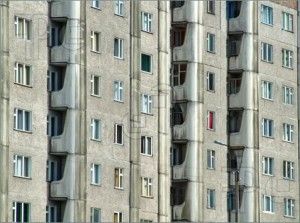California declares land war on families
By Wayne Lusvardi
Everyone knows that California has water wars. But it also has land wars. And one of the biggest battles is the state’s land war against zoning for the suburban single family home. And a war against single-family homes is a war against suburban families.
California’s shift in housing policy from stand-alone, single-family homes to multifamily units — apartments and condominiums — is an attempt to correct forecasted demographic imbalances between the old and the young. But is the demographic imbalance of too few young adults to support the entitlements of the elderly merely a problem for centralized planners?
CA’s Land War on the Family
Demographer Wendell Cox has recently compiled persuasive statistics that California has “declared war” on the single-family detached home.
California is planning to compel cities to zone land in the San Francisco Bay area so that more than two-thirds of all new housing construction would be for multi-family housing. In Southern California, central planning agencies want to require more than one half of all new housing to be located in very high density “public transit villages” (30 units per acre). The typical density for single-family homes is 4 per acre–the equivalent of a city lot of about 7,500 to 10,000 square feet.
The reason behind such a shift in housing policy is the decline in the proportion of intact, self-sufficient families to support the elderly.
 California Intact Families Have Declined
California Intact Families Have Declined
Like the rest of the United States, the number of intact self-sufficient families in California has leveled off or declined over the past few decades. The number of “Married Couple Families with Own Children” has declined by 121,260 families or 2.9 percent in California since 2000. (See Column F in the table below.)
Meanwhile, the percentage of single-family detached homes has declined in California by 0.3 percent relative to the population increase. (Column C in the table below.)
The proportion of the elderly has declined in California by 4.4 percent since 2000 (See Column E.)
But the number of young adults age 20 to 44 has also declined by 2.9 percent. (Column F.)
The ratio of all young adults to the elderly has declined from 4.1 young adults for every 1 elderly person in 2000 to 3.8 young adults foe every 1 senior in 2010 (Column I.)
The ratio of young intact families to the elderly has dropped from 2 to 1 in 2000 to 1.7 to 1 in 2010. (Column H.)
However, the policy of emphasizing multifamily housing over single-family housing would run against the grain of historical housing preferences and open markets.
Most People Want to Live in Single Family Homes
The National Association of Home Builders has tracked the historical ratio of newly built single-family and multi-family housing units.
In 1984 the trend in new housing construction was for about 2 single family detached homes to be built for every 1 apartment or condo unit. By 2010, that ratio rose to about 5 homes for every 1 apartment or condo unit.
This was long past the period when the Baby Boomers were making families. So the boom in single-family home construction was not entirely driven by the Baby Boomers. Thus, California’s shift to more multifamily housing is not all related to a decline in Baby Boomers buying houses. It has more to do with Baby Boomers retiring.
But what would this shift from two-thirds single family housing to two-thirds multifamily housing construction do to California’s economy?
California’s Family Economy and Obamacare
As pointed out by many prominent economists, the U.S. economy is dependent on the relative proportion of young self-sufficient families to the elderly. Intact, self-sufficient families produce young people who eventually take out mortgages and small business loans. In doing so, they provide the elderly with an interest rate return on their savings and pension investments. This intergenerational cycle of exchange of loans for interest rates is what makes the market economy work.
However, if there are not enough intact self-sufficient families to produce the next generation of homebuyers and small businesspersons then the economy stagnates. This is what has happened since about 1970. This is why jobs have declined in the United States and California (other than THE artificial jobs created during the Housing Bubble of the mid-2000s before it burst).
There is a demographic imbalance of too few two-parent/two-child self-sufficient households to pay the elderly a return on their savings.
Thus, Obamacare has surfaced as a way to compel young adults to buy health insurance so that the elderly can have their health care subsidized. The average premium for individual health care insurance was $4,940 per year in 2010. Obamacare is estimated to increase health insurance premiums by up to 30 percent, to $6,422. Young adults could elect to pay a fine of up to $695 by 2016 instead of buying health insurance. But then this would be nothing but a ruse for a new tax.
The elderly have six times the health care costs of the young. Obamacare would put a cap on the amount of health care costs of the elderly at 3 times what insurers charge young adults.
This is why California says it is going to move ahead with its own version of Obamacare, even if this june the U.S. Supreme Court throws out the individual mandate to buy insurance.
And for California to bring this about, it also must shift housing policy from building single-family homes to building mostly multifamily homes for young adults. It must build a demographic base of young people to support health care for the elderly, because there are not enough young intact families to do so anymore.
Obamacare Bakes Stagnation Into the Economic Cake
Let’s assume the U.S. Supreme Court validates the “individual mandate” of Obamacare, or declares it a matter for each state to decide. Obamacare would replace the existing intergenerational voluntary exchange system with a system of forced taxation of the young. What this will do is bake stagnation into the economic cake.
Young adults were never previously required to carry health insurance. To come up with about $6,000 per year for health insurance will mean fewer young adults will have money to buy cars or homes or start their own businesses. The intergenerational cycle of the market economy would waffle out of balance even more. Buying houses and cars and other big-ticket consumer items would decline. There would be less disposable income.
Home ownership historically has defined entry into the middle class. By limiting homeownership opportunities, there may be less socio-economic mobility for the young. The young would become nothing more than the modern equivalent of “tenant farmers” for taxes.
What centralized land planning offers is limited options of where to live. And it would freeze out Californians from the opportunity of home ownership. Obamacare, coupled with California’s centralized land planning, will limit housing options for most people to apartments or condominiums.
With Obamacare will come an even greater decline of the bourgeoisie family that is essential to a market economy. What makes economically productive families is not government policies or planning but social capital. Government central planners and regulatory czars can’t generate the kind of social capital needed to produce economically enterprising families.
Central Planning Has Failed
Should we leave housing and health care up to central planners, or devise more market-based solutions to address the problem? As shown with the Housing Bubble, central planning often has eventual catastrophic unintended consequences. Economist Guy Sorman notes that centralized planning hasn’t worked anywhere it has been tried.
The Housing Bubble policy of “easy money” mortgages tried to create artificial jobs and put renters into ownership housing to correct this demographic imbalance. This ruined the financial and banking systems, caused a bank panic in 2008, and diluted the value of the dollar. It has also decimated government and school district budgets and pension plans. Central planning has a bad track record.
What is behind the states’ new housing policies is California Senate Bill SB 375, the anti-urban sprawl bill signed into law by then-Gov. Arnold Schwarzenegger in 2008. Together with California’s version of Obamacare, it would limit future housing and health care cost options, especially for younger families. Californians need to know that state anti-urban sprawl legislation and likely state health care insurance mandates will limit their freedom of choice and resign California to nearly permanent economic stagnation.
California’s Family and Housing Economy 2000 and 2010
| 2000 | 2010 | Percent Change | ||
| A | Total Population | 33,871,648 | 37,691,912 | +11.3% +3,820,264 |
| B | No. Two Parent Families w/own Children | 2,989,974 (26%) |
2,977,944(24%) | -12,030 -12,030 (-2%) |
| C | No. Detached Single Family Housing Units | 6,883,493 (56.4%) |
7,877,273 (56.1%) |
+993,780 (-0.3%) |
| D | Median Family Size | 3.43 | 3.48 | +0.05 |
| E | No. ElderlyAge 65-84 | 3,171,059(9.4%) | 3,502,537(5.0%) | +331,478(-4.4%) |
|
F |
No. Married Couple Families w/Own Children under 18 yrs. old | 3,099,204(26.9%) | 2,977,944 (24.0%) |
-121,260 -2.9% |
| G | No. Young Adults Age 20 – 44 | 13,183,621 (39.0%) |
13,193,538 (36.1%) |
+9.917 (-2.9%) |
| H | Ratio of Young Intact Families to Elderly | 2 to 1 | 1.7 to 1 | -0.3 to 1 |
| I | Ratio of All Young Adults to Elderly | 4.1 to 1 | 3.8 to 1 | -0.3 to 1 |
| J | Median Family Income | $53,025 | $69,322 | +2.72%/year |
| K | Median Household Income | $47,453 | $60,883 | +2.52%/year |
| L | Per Capita Income | $22,711 | $29,188 | +2.54%/year |
| M | CPI Change | $1.00 | $1.27 | 2.42%/year |
Related Articles
Will High-Speed Rail Kill All Rail?
MARCH 30, 2011 The promise of California’s proposed high-speed rail network is unambiguous: the 800 miles of bullet trains across
Bankruptcy bill stuck in Assembly
May 30, 2012 By Katy Grimes Californians can heave a sigh of relief for the moment; the Assembly did not
Pulling Back CalPERS' Ethics Curtain
JAN. 7, 2010 By WAYNE LUSVARDI The Securities and Exchange Commission has exposed the self-righteous CalPERS, the California Public Employees



